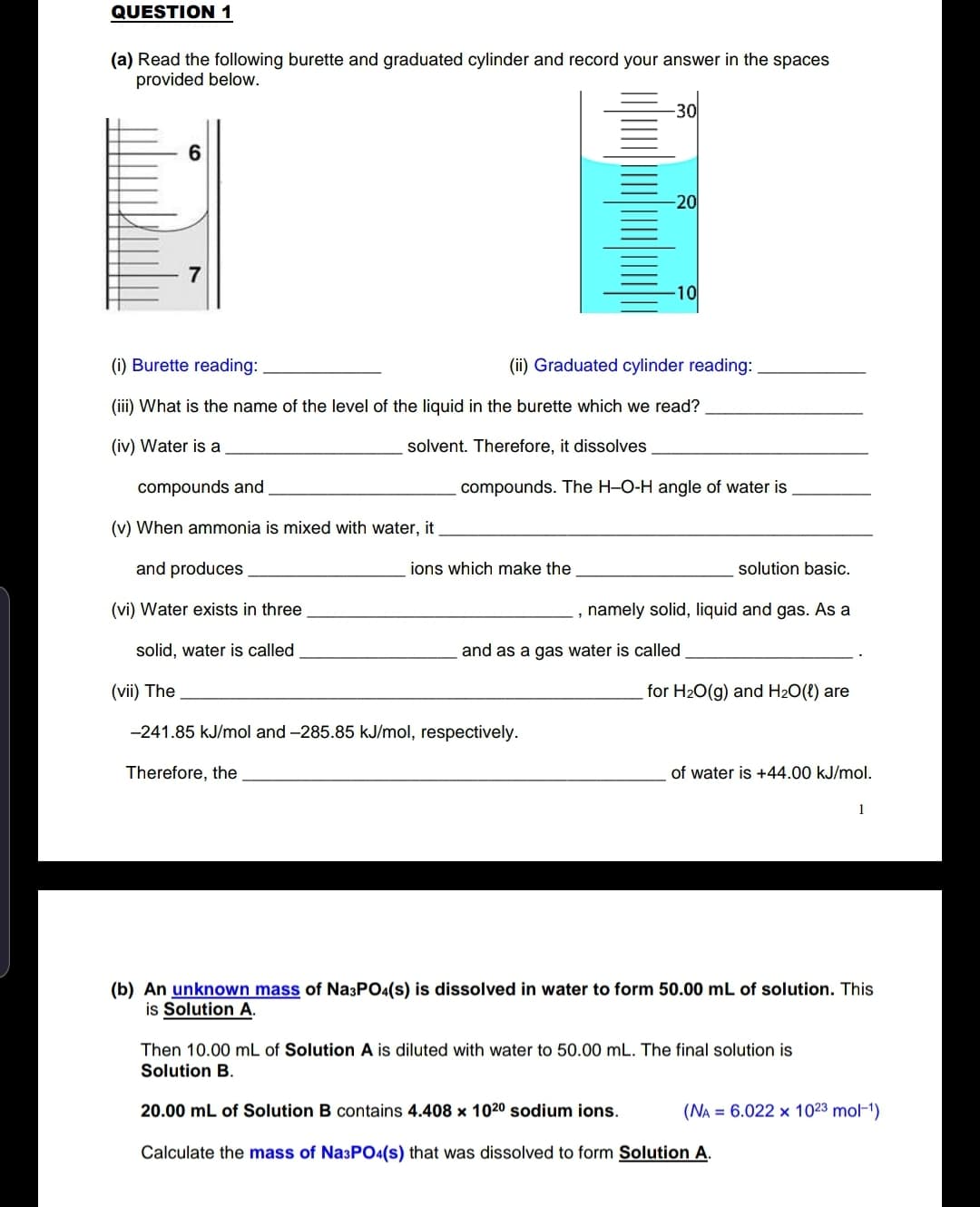(a) Read the following burette and graduated cylinder and record your answer in the spaces provided below. -30 6 -20 7 -10 (i) Burette reading: (ii) Graduated cylinder reading: (iii) What is the name of the level of the liquid in the burette which we read? (iv) Water is a solvent. Therefore, it dissolves compounds and compounds. The H-O-H angle of water is (v) When ammonia is mixed with water, it and produces ions which make the solution basic. (vi) Water exists in three , namely solid, liquid and gas. As a solid, water is called and as a gas water is called (vii) The for H20(g) and H2O(t) are -241.85 kJ/mol and -285.85 kJ/mol, respectively. Therefore, the of water is +44.00 kJ/mol. 1 (b) An unknown mass of Na3PO4(s) is dissolved in water to form 50.00 mL of solution. This is Solution A. Then 10.00 mL of Solution A is diluted with water to 50.00 mL. The final solution is Solution B. 20.00 mL of Solution B contains 4.408 x 1020 sodium ions. (NA = 6.022 x 1023 mol-1) Calculate the mass of Na3PO4(s) that was dissolved to form Solution A.
(a) Read the following burette and graduated cylinder and record your answer in the spaces provided below. -30 6 -20 7 -10 (i) Burette reading: (ii) Graduated cylinder reading: (iii) What is the name of the level of the liquid in the burette which we read? (iv) Water is a solvent. Therefore, it dissolves compounds and compounds. The H-O-H angle of water is (v) When ammonia is mixed with water, it and produces ions which make the solution basic. (vi) Water exists in three , namely solid, liquid and gas. As a solid, water is called and as a gas water is called (vii) The for H20(g) and H2O(t) are -241.85 kJ/mol and -285.85 kJ/mol, respectively. Therefore, the of water is +44.00 kJ/mol. 1 (b) An unknown mass of Na3PO4(s) is dissolved in water to form 50.00 mL of solution. This is Solution A. Then 10.00 mL of Solution A is diluted with water to 50.00 mL. The final solution is Solution B. 20.00 mL of Solution B contains 4.408 x 1020 sodium ions. (NA = 6.022 x 1023 mol-1) Calculate the mass of Na3PO4(s) that was dissolved to form Solution A.
Chemistry
10th Edition
ISBN:9781305957404
Author:Steven S. Zumdahl, Susan A. Zumdahl, Donald J. DeCoste
Publisher:Steven S. Zumdahl, Susan A. Zumdahl, Donald J. DeCoste
Chapter1: Chemical Foundations
Section: Chapter Questions
Problem 1RQ: Define and explain the differences between the following terms. a. law and theory b. theory and...
Related questions
Question

Transcribed Image Text:(a) Read the following burette and graduated cylinder and record your answer in the spaces
provided below.
-30
6
-20
7
-10
(i) Burette reading:
(ii) Graduated cylinder reading:
(iii) What is the name of the level of the liquid in the burette which we read?
(iv) Water is a
solvent. Therefore, it dissolves
compounds and
compounds. The H-O-H angle of water is
(v) When ammonia is mixed with water, it
and produces
ions which make the
solution basic.
(vi) Water exists in three
, namely solid, liquid and gas. As a
solid, water is called
and as a gas water is called
(vii) The
for H20(g) and H2O(t) are
-241.85 kJ/mol and -285.85 kJ/mol, respectively.
Therefore, the
of water is +44.00 kJ/mol.
1
(b) An unknown mass of Na3PO4(s) is dissolved in water to form 50.00 mL of solution. This
is Solution A.
Then 10.00 mL of Solution A is diluted with water to 50.00 mL. The final solution is
Solution B.
20.00 mL of Solution B contains 4.408 x 1020 sodium ions.
(NA = 6.022 x 1023 mol-1)
Calculate the mass of Na3PO4(s) that was dissolved to form Solution A.
Expert Solution
This question has been solved!
Explore an expertly crafted, step-by-step solution for a thorough understanding of key concepts.
This is a popular solution!
Trending now
This is a popular solution!
Step by step
Solved in 5 steps with 8 images

Knowledge Booster
Learn more about
Need a deep-dive on the concept behind this application? Look no further. Learn more about this topic, chemistry and related others by exploring similar questions and additional content below.Recommended textbooks for you

Chemistry
Chemistry
ISBN:
9781305957404
Author:
Steven S. Zumdahl, Susan A. Zumdahl, Donald J. DeCoste
Publisher:
Cengage Learning

Chemistry
Chemistry
ISBN:
9781259911156
Author:
Raymond Chang Dr., Jason Overby Professor
Publisher:
McGraw-Hill Education

Principles of Instrumental Analysis
Chemistry
ISBN:
9781305577213
Author:
Douglas A. Skoog, F. James Holler, Stanley R. Crouch
Publisher:
Cengage Learning

Chemistry
Chemistry
ISBN:
9781305957404
Author:
Steven S. Zumdahl, Susan A. Zumdahl, Donald J. DeCoste
Publisher:
Cengage Learning

Chemistry
Chemistry
ISBN:
9781259911156
Author:
Raymond Chang Dr., Jason Overby Professor
Publisher:
McGraw-Hill Education

Principles of Instrumental Analysis
Chemistry
ISBN:
9781305577213
Author:
Douglas A. Skoog, F. James Holler, Stanley R. Crouch
Publisher:
Cengage Learning

Organic Chemistry
Chemistry
ISBN:
9780078021558
Author:
Janice Gorzynski Smith Dr.
Publisher:
McGraw-Hill Education

Chemistry: Principles and Reactions
Chemistry
ISBN:
9781305079373
Author:
William L. Masterton, Cecile N. Hurley
Publisher:
Cengage Learning

Elementary Principles of Chemical Processes, Bind…
Chemistry
ISBN:
9781118431221
Author:
Richard M. Felder, Ronald W. Rousseau, Lisa G. Bullard
Publisher:
WILEY